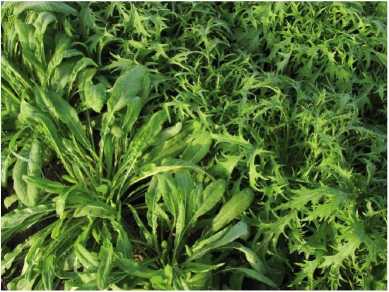6570141207
133
Ęffect ofgrowing datę and cultivar on the morphologicalparameters andyield...
the end of August. The experimental objects included 4 replications, on each plot there were 30 plants (with the marginal belts). The plot intended for the yields was 2.4 m2 and covered 24 plants. The amount of fertilizers was calculated on the base of soil analyzes to achieve the content of nutrients (in 1 dm3 of soil) on the level of 100 mg N, 80 mg P. 150 mg K and 1500 mg Ca. During harvesting the weight of each single rosette and the number of the plants from the plot were precisely defined. The marketable yield consi-sted of the rosettes without damages, ripe, healthy. The yield with no market value included the plants with disease symptoms, damages madę by insects, defonned. The share of the marketable yield in the total yield was calculated based on the amount of the marketable rosettes vs. all harvested plants. The first harvest took place around tire mid-dle of September (lsl tenn) or in the first ten days of October (21*1 term). The production of the vegetable crop in the fields condition in the lsl term took about 30 days from planting, whereas in the 2nd tenn - 42 days.

Fig. 1. Plants of Brassica rapa war.japonica cv. Mibuna (on the left) and Mizuna (on the right) Rys. 1. Rośliny Brassica rapa var. japonica odm. Mibuna (po lewej) oraz Mizuna (po prawej)
During field cultivation the microclimate conditions were automatically registered (air temperaturę) using the autonomous sensors HOBO Pro RH/Temp. (Onset Computer Corp., USA) with 1-hour intervals. The data was compiled in tenns of twenty four hours and used to calculate the average air temperaturę in the suitable periods of cultivation (tab. 1). The data conceming the rainfalls gained from IMGW (Institute of Meteorology and Water Management) station in Krakow-Balice was also included.
Before the planting out the morphology evaluation of the transplants from each ex-perimental object was conducted. The measurements included: the transplant height, the number of leaves per plant (leaves that were longer than 1 cm), the area of visually
Hortorum Cultus 11(3) 2012
Wyszukiwarka
Podobne podstrony:
143 Effect ofgrowing datę and cultivar on the morphological paranie ters and yield... Świąder M., 20
135 Effect ofgrowing datę and cultivar on the morphological paranie ters and yield... comes to the l
137 Effect ofgrowing datę and cultivar on the morphological paranie ters and yield... "Ck 1* te
139 Effect ofgrowing datę and cultivar on the morphological paranie ters and yield... matter was obs
SACTA 2 ActaSci. Pol, Hortorum Cultus 11(3) 2012, 131-143EFFECT OF GROWING DATĘ AND CULTIVAR ON THE
134 Table 5.1 Model selection testing for the effect of period and group (i.e. cohort and age) on th
img025 The Letters K & L The K has a straight piece on the Ieft, and a bend on the right. These
C..A. Mascardi (Orał discussion) Few comments can be added to the contributions by Martinetti and Di
17ccw03 ~n hQtQiQe©You are siufiiig as:Membername: Password: W Storę your membername and password on
INFOST XXX Page 4 of 7 ASSIGNMENTS: Assignments are due on the specified datę (midnight CST on the d
img019 (16) They walk to her fire, and stand on the feet. And still she sits, and still she sews, an
scratches and fingerprints on the disc surface. Over and above that, according to the specifications
BOOKS AND PAMPHLETS On the stresses induced by flexure in a deep rectangular beam, by D.R. Smith and
C..A. Mascardi (Orał discussion) Few comments can be added to the contributions by Martinetti and Di
więcej podobnych podstron